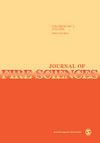密闭空间内扩散冲击火焰扩展试验研究及危险性分析
IF 1.9
4区 工程技术
Q2 ENGINEERING, MULTIDISCIPLINARY
引用次数: 3
摘要
在这项工作中,对有限空间中的扩散撞击火焰进行了实验研究。目的是研究限制对火焰撞击天花板行为的影响,并推断限制室内产生的烟雾的自燃风险。为此,根据隔间内窗户和/或门的条件,构建了具有五个限制水平的配置,热释放率的变化在0.5到18.6之间 为了评估火焰形态和火焰延伸长度,采用了基于直接线性变换算法和火焰分割算法的图像处理方法。从实验数据来看,4.6 kW是受限配置中火焰扩展的临界值,对应于大于1的外壳当量比,突出了通风不足的环境。此外,还对车厢内有未燃烧气体的烟雾进行了自燃风险分析。将这些气体的浓度和温度与可燃性下限和自燃温度进行比较。据观察,天花板下的烟雾存在自燃风险,尤其是在当量比大于1的密闭隔间中。在这种情况下,火灾有可能蔓延到另一个隔间。本文章由计算机程序翻译,如有差异,请以英文原文为准。
Experimental study on the flame extension and risk analysis of a diffusion impinging flame in confined compartment
In this work, an experimental investigation on a diffusion impinging flame in a confined compartment was performed. The objective was to study the influence of confinement on the behavior of a flame impinging the ceiling and to deduce the auto-ignition risk of the smoke produced in the confined compartment. For this, configurations with five confinement levels were constructed by the condition of windows and/or door in the compartment and the variation of the heat release rates was made between 0.5 and 18.6 kW. To evaluate the flame morphology and flame extension length, an image processing method based on the direct linear transformation algorithm and the fire segmentation algorithm was adopted. From the experimental data, it was shown that the heat release rate of 4.6 kW presents a critical value for the flame extension in confined configurations, which corresponds to the equivalence ratio of the enclosure greater than 1, highlighting an under-ventilated environment. In addition, an auto-ignition risk analysis of smoke with unburnt gas in the compartment was carried out. The concentration and temperature of these gases were compared to the lower flammability limits and the auto-ignition temperature. It was observed that there was auto-ignition risk of the smoke under the ceiling, especially in the confined compartment of equivalence ratio greater than 1. Under these conditions, it is possible to have a fire spread to another compartment.
求助全文
通过发布文献求助,成功后即可免费获取论文全文。
去求助
来源期刊

Journal of Fire Sciences
工程技术-材料科学:综合
CiteScore
4.00
自引率
0.00%
发文量
14
审稿时长
2.5 months
期刊介绍:
The Journal of Fire Sciences is a leading journal for the reporting of significant fundamental and applied research that brings understanding of fire chemistry and fire physics to fire safety. Its content is aimed toward the prevention and mitigation of the adverse effects of fires involving combustible materials, as well as development of new tools to better address fire safety needs. The Journal of Fire Sciences covers experimental or theoretical studies of fire initiation and growth, flame retardant chemistry, fire physics relative to material behavior, fire containment, fire threat to people and the environment and fire safety engineering. This journal is a member of the Committee on Publication Ethics (COPE).
 求助内容:
求助内容: 应助结果提醒方式:
应助结果提醒方式:


